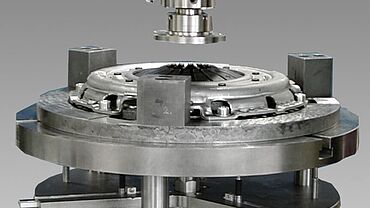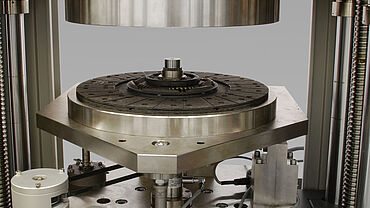Testing of the drive train
Wherever power is converted and transferred, tests ensure the reliability of the installed component. ZwickRoell has over 50 years of experience testing engine and drive components. Initially, the load tests performed were simple, but today extremely specific properties must be measured and documented, and also at high speeds, torques, and extreme temperatures.
Testing of clutches
The characteristic curves of the contact force and travel, as well as release force and travel, are important in both the development and production control of friction clutches. You can also determine the release stroke of the clutch pressure plate and the parallelism of the pressure plate to the clutch plate. The characteristic curves for the release force/travel and contact force/travel are not only important for comfortable operation but also for safe clutch torque transfer. In release testing, the compression die is pressed against the inner diameter of the diaphragm spring and the force/travel curve is recorded. In contact testing, a compression die is pressed directly against the clutch pressure plate, and the spring characteristic curve of the diaphragm spring between the clutch pressure plate and clutch cover is measured. These tests are performed in new condition and in the defined used condition.


Axial and torsional measurements on clutch disks
Dry friction clutches are also used to apply (comfortable acceleration) and to interrupt the torque flow. In addition to the aforementioned axial characteristic curves, torque characteristic curves are therefore also extremely important, for example,
- Zero crossing (average value of angle of rotation between loading and unloading)
- Pre-damper and main damper characteristic curve (angle or torque controlled)
- Partial curve (for determining the friction coefficient)
- Drag torque (minimum permissible torque after releasing the clutch)
In addition to torque characteristic curves, the following axial curves are determined: characteristic curve of cushioning springs (force/travel characteristic curve of the spring between the clutch plates), non-parallelism (measurement of non-parallelism at preload), and thickness of clutch plates (measurement of plate thickness at preload).
